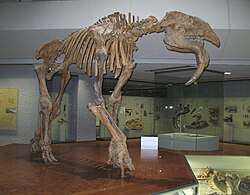Deinotherium
Deinotherium was a large proboscidean related to modern elephants. Their downward curving tusks are notable. They are known from the middle Miocene to the early Pleistocene. Deinotherium is put in its own family (the Deinotheriidae) in the Proboscidea.
| Deinotherium Temporal range: Middle Miocene – Early Pleistocene
| |
|---|---|
| 260px | |
| Illustration of Deinotherium | |
| Scientific classification | |
| Kingdom: | |
| Phylum: | |
| Class: | |
| Order: | |
| Suborder: | |
| Family: | |
| Genus: | †Deinotherium Kaup, 1829
|
There were several species of Deinotherium that lived in parts of Africa, Asia and Europe. The Deinotherium was larger than today’s elephants.
The way Deinotherium used its curious tusks has been much debated. It may have rooted in soil for underground plant parts like roots and tubers, pulled down branches to snap them and reach leaves, or stripped soft bark from tree trunks.[1][2]
It helps to remember that the Miocene was much warner and wetter than today, and that the Africa of the Miocene had rather different fauna from today. Deinotherium was a creature of muddy tropical rivers and forests, not the dry savannahs of today. It also lived in southern Europe and east to the Indian Subcontinent.
Deinotherium fossils have been uncovered at several of the African sites where remains of prehistoric hominid relatives of modern humans have also been found.
Deinotherium Media
Deinotherium giganteum model at the Natural History Museum Mainz
Mount of ancestor, Prodeinotherium
References
- ↑ Harris J.M. 1976. Evolution of feeding mechanisms in the family Deinotheriidae (Mammalia: Proboscidea). Zool. J. Linn. Soc. 56: 331-362
- ↑ Konidaris G.E.; Roussiakis S.J.; Athanassiou A.; Theodorou G.E. 2017. Reprint of: The huge-sized deinothere Deinotherium proavum (Proboscidea, Mammalia) from the Late Miocene localities Pikermi and Halmyropotamos (Greece). Quaternary International. 445: 5–22. Bibcode:2017QuInt.445....5K. doi:10.1016/j.quaint.2017.07.038




